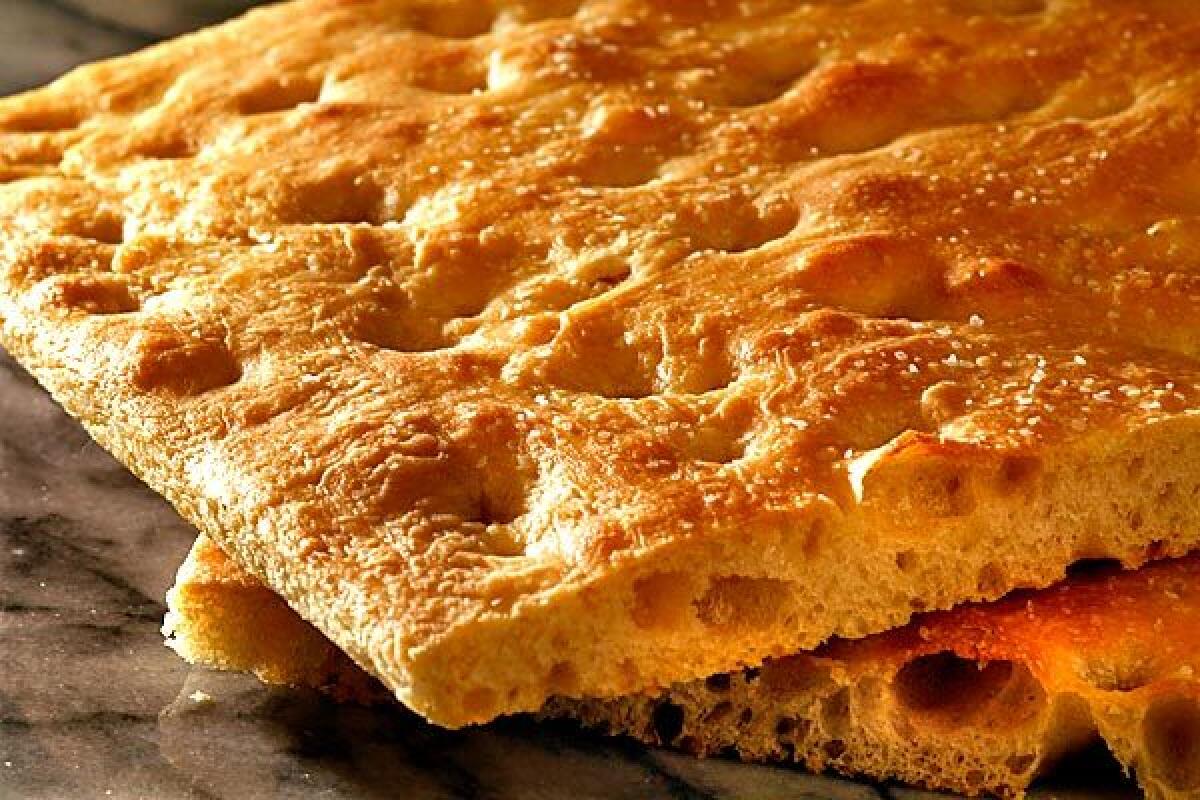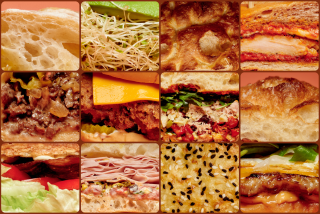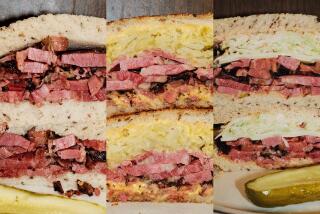California Cook: Focaccia as it was meant to be

When a television series has devolved so far from its original premise that it reaches a kind of nonsensical absurdity, we say it has jumped the shark. That’s usually a good time to go back and take a fresh look at what made the original work so well. The culinary equivalent might be something getting used in a fast-food sandwich. And so it’s time to get back to basics with focaccia.
I ordered a sandwich at my local lunch counter the other day and the guy asked me what kind of bread I wanted: “White, whole wheat or focaccia,” the latter a flattish white bread topped with what appeared to be sliced tomatoes, onions, cheese and lord knows what else.
In going public with these kinds of complaints, there’s always a danger of coming off all Andy Rooney-ish. I’m neither that old nor that perturbed. So I’m going to take the high road, praising true focaccia without stooping to condemn “focaccia bread.” I’ll leave it up to you to decide which you prefer. And I know you’ll do the right thing.
Real focaccia is a lot closer to pizza than it is to anything that could be used to make a sandwich. In fact, if you imagine a slightly thicker, crisp-crusted, rectangular pizza with very restrained toppings, you’re just about there.
But although pizza can stand in for a full meal, focaccia is more of a snack, or at most an appetizer. In Italy, it’s a popular walking-around food.
Also, although cold pizza may have a certain raffish charm, focaccia really needs to be eaten when it’s hot to be at its best. It stales very quickly. Though I’m enjoying the slice of focaccia topped with Gorgonzola that I’m eating for lunch while writing this, in no way is it nearly as good as it was last night right out of the oven.
Then, I served it with Champagne to start a dinner party. Served warm, the crust was crisp while the interior, rich with olive oil, was tender. The cheese had melted and browned, and the flavor was much more mellow than you might expect from a blue. The whole thing was deeply savory and made a perfect foil served alongside radishes from the garden and some thinly sliced dried sausage.
It was also really easy to make because, thanks to a couple of weeks of focaccia experiments, I had a blob of already-made dough sitting in the freezer. After defrosting, I just stretched it into a well-oiled jellyroll pan (a generous hand with the olive oil gives a crisper crust), then scattered a half pound of crumbled Gorgonzola on top and baked it. That was all there was to it.
Most focaccias aren’t any more complicated than that, because the toppings tend to the austere. Thinly sliced onions drizzled with olive oil, pitted olives, cubed pancetta with a scattering of rosemary leaves — to complicate a focaccia topping is to misunderstand its elemental appeal.
But don’t mistake simplicity for lack of flavor. My favorite focaccia is topped with nothing more than good olive oil and coarse salt. Made the Genovese way — with plenty of olive oil and white wine in the crust — it’s so delicious I could eat it all day.
Of the half dozen recipes I tried, my favorite comes from Carol Field. For those of you who love Italian cooking, that probably will come as no surprise, as her “The Italian Baker,” published more than 25 years ago, is still the definitive book on Italian breads.
This recipe is from a small book she did 15 years ago called simply “Focaccia.” The dough’s easy to make and very silky to work with. Even better, unlike many focaccia recipes, it doesn’t require an overnight rise, so you can knock it together with a minimum of forethought — always a plus at my house, where meal planning tends to go on an hour-by-hour basis.
Ornamenting this focaccia with a topping of some sort would obscure its main pleasures: the crunchy crust and the pure flavors of olive oil, wheat and salt. For focaccia that will be topped, I prefer a plainer dough, such as the one Peter Reinhart includes in his ode to pizza, “American Pie.”
While Field’s book is based in the first wave of artisanal home bread baking, Reinhart’s is right up to the cutting edge. His focaccia is based on one of those “retarded” doughs — refrigerated overnight to slow the fermentation and allow a longer period of enzymatic action, resulting in more complex flavors. He also uses a minimum of handling to keep from deflating the dough. And stylistically his focaccia is thicker and “breadier” than Field’s.
Focaccia doughs in general tend to be fairly fluid — particularly if you’re used to making heartier breads. Bread bakers talk about percentage of hydration — the ratio of water to flour. While most bread doughs are around 60%, focaccias generally run 70% and higher. I even tested one that was more than 100%.
Doughs this wet feel almost like batters, but that is the secret to focaccia’s delicious crispness. It also facilitates the shaping. If you’ve struggled stretching out perfect pizza rounds, focaccia will be a welcome relief. Essentially, all you do is spread the dough into a jellyroll pan. If it doesn’t fit perfectly at first, just set it aside for a couple of minutes to let the dough rest and it shouldn’t give you any more trouble.
After it’s stretched, dimple the dough by lightly tapping it all over with your fingertips. Remember, you’re dimpling, not indenting, and certainly not piercing. After a second rise, dimple lightly again and you’re ready to top and bake.
There are a couple of other things that help make a crisper crust. Bake the focaccia on a pizza stone set on a rack in the middle of the oven. And slide a pan of water onto the floor of the oven to help with crispness and improve “oven spring” — that final rise that happens after the bread starts to bake.
The bread is done when it is well-browned on top and on the bottom. If you oiled the pan sufficiently, you should be able to use a spatula to lift a corner of the bread to see. Let it cool for just a couple of minutes, and then cut it into slabs.
Just out of the oven, the crust gives off a warm fragrance of good olive oil. It crunches lightly when you bite into it, but the interior is still tender and just chewy enough to be interesting. The salt adds a sharp contrast.
Eat it as a snack, serve it as an appetizer, however you like. But if you turn it into a sandwich, I don’t want to know about it.
More to Read
Eat your way across L.A.
Get our weekly Tasting Notes newsletter for reviews, news and more.
You may occasionally receive promotional content from the Los Angeles Times.











